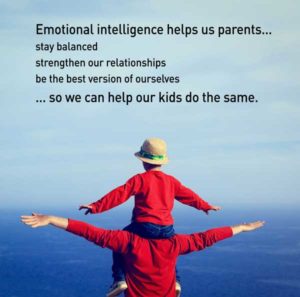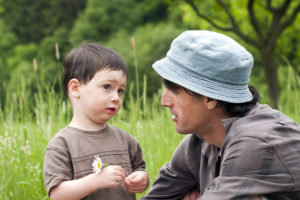How to Talk to Kids About Fear and Trauma, Part II
It’s difficult enough that, as parents, we struggle to find answers to the everyday issues with our kids, such as how to get them to eat more veggies, do their chores, and be kind to their siblings. When it comes to trauma and fear, parents get a little nervous about doing it right.
This is partly because as parents, we have a lot of fear ourselves. We worry that if not addressed, this fear might seep into other areas and affect the quality of our kids’ lives or that we might traumatize them more and make matters worse. At times, the fear may be so great that we might avoid talking about them altogether.The challenge with fear is this: the more we fear, the more power we give it.
Fear Is Just Another Emotion
We start by understanding that fear, like any other emotion, is information from our brain to ourselves. For example, anger focuses our energy to solve a problem that stands in the way. Sadness signals that we may be losing something important. Jealousy hints at what we want more of. Fear motivates us to protect ourselves from some potential threat.
In part I of this blog post I talked about how my sons and I were nearly crushed by a large oak tree on our way home from a nature day. It was fear that pushed me to slam on the brakes that saved us from hit by or colliding with the tree. By recognizing fear as just another emotion, we appropriate a space for it in our emotional life and retain the power to deal with it.
Put Fear in Its Place
 The surest way to give fear more power is to push it away, to suppress it, to deny or to avoid it. It is as if the alarm has been set off, and we don’t turn it off or reset it, and we let the blurring sounds vibrate throughout our body for hours on end. As a result, our stress level will rise; and this alert state becomes the filter through which we approach everything. We’re no longer in control and have allowed the alarm system to take over.
The surest way to give fear more power is to push it away, to suppress it, to deny or to avoid it. It is as if the alarm has been set off, and we don’t turn it off or reset it, and we let the blurring sounds vibrate throughout our body for hours on end. As a result, our stress level will rise; and this alert state becomes the filter through which we approach everything. We’re no longer in control and have allowed the alarm system to take over.
Fear vs. Trauma
I think it’s important to take a moment to talk about the difference between momentary fear and trauma. The former passes without lasting effects, whereas the latter can create a deep chemical pattern or groove in the brain where the fear gets replayed again and again in response to triggers that remind the brain of what happened.
It can cause sleeplessness, anxiety, malfunction in daily life and even depression. While there has been much research on Post Traumatic Stress Disorder (PTSD) and trauma in adults, there is only rudimentary understanding of PTSD or trauma in children and adolescents. For more information on this, please visit APA website.
Put Your Oxygen Mask On First
 I’ve come to realize that the steps to processing our fears and emotions with our kids need to be a parallel path, whereby parents are processing their emotions along with their kids. We cannot expect to skip over our own emotions and help kids with theirs first. As on any plane ride, always put your oxygen mask on first, then help your child to put on hers.
I’ve come to realize that the steps to processing our fears and emotions with our kids need to be a parallel path, whereby parents are processing their emotions along with their kids. We cannot expect to skip over our own emotions and help kids with theirs first. As on any plane ride, always put your oxygen mask on first, then help your child to put on hers.
A 5-Steps Process
Since our close call with a fallen oak tree that nearly crushed us, I have been preoccupied with the question of how to talk to my kids about fear and trauma. Immediately after we got home on the day of incident, my boys and I talked about all the emotions we felt during the incident and afterwards. We wrote some poems about the emotions that arose.
The poems allowed us to access the full potential of what we were feeling and to integrate them into understanding ourselves and our re actions to the situation, and ultimately to move beyond them. Here are five steps I used to work through the feelings of fear with my kids:
actions to the situation, and ultimately to move beyond them. Here are five steps I used to work through the feelings of fear with my kids:
 Pause and breathe – First and foremost, take a few deep breaths, or a “6 Seconds Pause”. This involves thinking of 6 things that make you happy: 6 favorite songs, 6 favorite persons, 6 favorite vacation spots, etc. This is a tool that you always have in your back pocket if talking about fear is scary for you.
Pause and breathe – First and foremost, take a few deep breaths, or a “6 Seconds Pause”. This involves thinking of 6 things that make you happy: 6 favorite songs, 6 favorite persons, 6 favorite vacation spots, etc. This is a tool that you always have in your back pocket if talking about fear is scary for you.
 Share your own feelings – This has the dual benefits of modeling for your kids and helping you to name your own emotions. One of the essential skills in emotional intelligence is the ability to read your own emotions and those of others. In order to get better at this, you can practice identifying the emotions and labeling them. The science behind “Name it to tame it” involves engaging our prefrontal cortex to take the control back from the amygdala so that the thinking area is integrated with the emotional part of the brain. Once labeled, the emotion, no matter how powerful, loses its grip on you. My boys and I were naming a variety of emotions on our ride home after the incident, which was the start of our processing them.
Share your own feelings – This has the dual benefits of modeling for your kids and helping you to name your own emotions. One of the essential skills in emotional intelligence is the ability to read your own emotions and those of others. In order to get better at this, you can practice identifying the emotions and labeling them. The science behind “Name it to tame it” involves engaging our prefrontal cortex to take the control back from the amygdala so that the thinking area is integrated with the emotional part of the brain. Once labeled, the emotion, no matter how powerful, loses its grip on you. My boys and I were naming a variety of emotions on our ride home after the incident, which was the start of our processing them.
 Ask your child about his feelings
Ask your child about his feelings
-Now you’re creating space for your child to name his emotions. You might feel anxious about not knowing what to do when he tells you his emotions. The idea here is not to “do” anything in this step. You are simply providing him with an open heart and listening ears.
 The most important thing in this step is to validate his emotions, whatever they may be. You may validate by saying, “I see”, “I understand”, “I don’t blame you”. Sometimes, it’s not even necessary to say anything. Just listen with your whole body and be fully present. He will sense your empathy through your body language and nuances. In some situations, this step may be all your child needs to self regulate and return to himself again.
The most important thing in this step is to validate his emotions, whatever they may be. You may validate by saying, “I see”, “I understand”, “I don’t blame you”. Sometimes, it’s not even necessary to say anything. Just listen with your whole body and be fully present. He will sense your empathy through your body language and nuances. In some situations, this step may be all your child needs to self regulate and return to himself again.
 Co-actively navigate the fear – As I did with my sons, I offered them an opportunity to write or draw about the incident. The process of understanding what happened and naming the feelings in their own words with imagery helped them to put things into context. “Emotions happen in both sides of the brain but they may be more direct or spontaneous on the right,” according to Daniel Siegel.
Co-actively navigate the fear – As I did with my sons, I offered them an opportunity to write or draw about the incident. The process of understanding what happened and naming the feelings in their own words with imagery helped them to put things into context. “Emotions happen in both sides of the brain but they may be more direct or spontaneous on the right,” according to Daniel Siegel.
This is why it’s important to develop a process for reflection by engaging the right brain too. This may include poetry, drawing, painting, making up a song, creating a physical product as to symbolize the emotions. This process may be a bit intense; but with your loving guidance, they can get through it while feeling safe and supported.
Transform the feeling of fear – Help your child understand, that all emotions are data for us and it’s up to us to use them wisely. Fear is a critical emotion for our survival. On the other hand, when we are flooded by fear on a daily basis, we might be paralyzed by its power. To leverage its power, it is important to recognize when this “friend” is visiting, welcome it for a quick cup of tea, and bid farewell once fear has had a chance to deliver his message.
 When you sit with the feeling of fear and look at it in the face, over cup of tea, you will see it as a friend and learn to read the messages it sends. Then you might thank it for helping to protect you and send it on its way. With enough practice, you might start to feel as if you can anticipate when fear will visit again and you can prepare the tea ahead of time. The visit with fear will become shorter and shorter. Over time, you might just need a teleconference! This is when you are able to harness the power of fear: extract what info you need from it and let it go!
When you sit with the feeling of fear and look at it in the face, over cup of tea, you will see it as a friend and learn to read the messages it sends. Then you might thank it for helping to protect you and send it on its way. With enough practice, you might start to feel as if you can anticipate when fear will visit again and you can prepare the tea ahead of time. The visit with fear will become shorter and shorter. Over time, you might just need a teleconference! This is when you are able to harness the power of fear: extract what info you need from it and let it go!
I hope you find the suggested process helpful. I’d love to hear your thoughts as you try these tips out. You may be dealing with your child’s fear of spiders, monsters in the night, or trepidation about natural disasters. The fears may differ in circumstances and to different degrees, but the general process is similar.
You may try the five steps of taking pause, sharing your feelings, asking about theirs, brainstorming solutions together, and helping to channel their feelings towards an agreed upon objective.
Do you have your own tip or advice for dealing with fear that works well for your child? Please leave a comment below. Your feedback is essential and enriching to other parents as we all work to build a thriving community of parents practicing emotional intelligence. Thank you for your engagement!
- 10 Simple Ways to Build Trust as a Parent - August 22, 2017
- Scared Excited: Talking to Children About Trauma - July 6, 2016


Excellent article, especially this line: By recognizing fear as just another emotion, we appropriate a space for it in our emotional life and retain the power to deal with it.
As a mama of two kiddos, I also struggle with explaining and addressing trauma and fear with them. This article is incredibly helpful. Thank you!